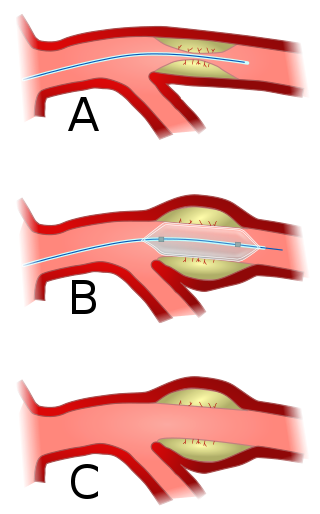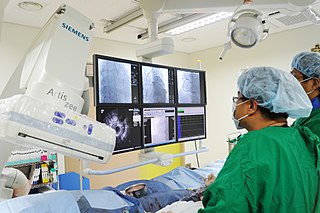
Angioplasty, also known as balloon angioplasty and percutaneous transluminal angioplasty (PTA), is a minimally invasive endovascular procedure used to widen narrowed or obstructed arteries or veins, typically to treat arterial atherosclerosis.

In medicine, a stent is a tube usually constructed of a metallic alloy or a polymer. It is inserted into the lumen of an anatomic vessel or duct to keep the passageway open. Stenting refers to the placement of a stent. The word "stent" is also used as a verb to describe the placement of such a device, particularly when a disease such as atherosclerosis has pathologically narrowed a structure such as an artery.

A coronary catheterization is a minimally invasive procedure to access the coronary circulation and blood filled chambers of the heart using a catheter. It is performed for both diagnostic and interventional (treatment) purposes.

Restenosis is the recurrence of stenosis, a narrowing of a blood vessel, leading to restricted blood flow. Restenosis usually pertains to an artery or other large blood vessel that has become narrowed, received treatment to clear the blockage and subsequently become renarrowed. This is usually restenosis of an artery, or other blood vessel, or possibly a vessel within an organ.

Coronary thrombosis is defined as the formation of a blood clot inside a blood vessel of the heart. This blood clot may then restrict blood flow within the heart, leading to heart tissue damage, or a myocardial infarction, also known as a heart attack.

Percutaneous coronary intervention (PCI) is a minimally invasive non-surgical procedure used to treat narrowing of the coronary arteries of the heart found in coronary artery disease. The procedure is used to place and deploy coronary stents, a permanent wire-meshed tube, to open narrowed coronary arteries. PCI is considered 'non-surgical' as it uses a small hole in a peripheral artery (leg/arm) to gain access to the arterial system, an equivalent surgical procedure would involve the opening of the chest wall to gain access to the heart area. The term 'coronary angioplasty with stent' is synonymous with PCI. The procedure visualises the blood vessels via fluoroscopic imaging and contrast dyes. PCI is performed by an interventional cardiologists in a catheterization laboratory setting.

A drug-eluting stent (DES) is a self-expanding tube made of a mesh-like material used to treat narrowed arteries (stenosis) in medical procedures. It is inserted into a narrowed artery using a balloon. Once the balloon inside the stent is inflated, the stent expands, pushing against the artery wall. The mesh design allows cells to grow through and around it, securing it in place. The stent slowly releases a drug to prevent re-blockage of the artery. The release of the drug from the stent to prevent the growth of scar tissue and reduce the risk of stent restenosis, which is the narrowing of the stented area of an artery after treatment. A drug-eluting stent is different from other types of stents because it has a coating that delivers medication directly to the arterial wall. A DES is often made of metal alloys and can be inserted into blocked or narrowed arteries through a catheter placed in a peripheral artery, such as in the arm or leg. DES is fully integrated with a catheter delivery system and is viewed as one integrated medical device.
Phosphorylcholine is the hydrophilic polar head group of some phospholipids, which is composed of a negatively charged phosphate bonded to a small, positively charged choline group. Phosphorylcholine is part of the platelet-activating factor; the phospholipid phosphatidylcholine and sphingomyelin, the only phospholipid of the membrane that is not built with a glycerol backbone. Treatment of cell membranes, like those of RBCs, by certain enzymes, like some phospholipase A2, renders the phosphorylcholine moiety exposed to the external aqueous phase, and thus accessible for recognition by the immune system. Antibodies against phosphorylcholine are naturally occurring autoantibodies that are created by CD5+/B-1 B cells and are referred to as non-pathogenic autoantibodies.
The history of invasive and interventional cardiology is complex, with multiple groups working independently on similar technologies. Invasive and interventional cardiology is currently closely associated with cardiologists, though the development and most of its early research and procedures were performed by diagnostic and interventional radiologists.
Fractional flow reserve (FFR) is a diagnostic technique used in coronary catheterization. FFR measures pressure differences across a coronary artery stenosis to determine the likelihood that the stenosis impedes oxygen delivery to the heart muscle.

A coronary stent is a tube-shaped device placed in the coronary arteries that supply blood to the heart, to keep the arteries open in patients suffering from coronary heart disease. The vast majority of stents used in modern interventional cardiology are drug-eluting stents (DES). They are used in a medical procedure called percutaneous coronary intervention (PCI). Coronary stents are divided into two broad types: drug-eluting and bare metal stents. As of 2023, drug-eluting stents were used in more than 90% of all PCI procedures. Stents reduce angina and have been shown to improve survival and decrease adverse events after a patient has suffered a heart attack—medically termed an acute myocardial infarction.

Zotarolimus is an immunosuppressant. It is a semi-synthetic derivative of sirolimus (rapamycin). It was designed for use in stents with phosphorylcholine as a carrier. Zotarolimus, or ABT-578, was originally used on Abbott's coronary stent platforms to reduce early inflammation and restenosis; however, Zotarolimus failed Abbott's primary endpoint to bring their stent/drug delivery system to market. The drug was sold/distributed to Medtronic for use on their stent platforms, which is the same drug they use today. Coronary stents reduce early complications and improve late clinical outcomes in patients needing interventional cardiology. The first human coronary stent implantation was first performed in 1986 by Puel et al. However, there are complications associated with stent use, development of thrombosis which impedes the efficiency of coronary stents, haemorrhagic and restenosis complications are problems associated with stents.

A bare-metal stent is a stent made of thin, uncoated (bare) metal wire that has been formed into a mesh-like tube. The first stents licensed for use in cardiac arteries were bare metal – often 316L stainless steel. More recent "second generation" bare-metal stents have been made of cobalt chromium alloy. While plastic stents were first used to treat gastrointestinal conditions of the esophagus, gastroduodenum, biliary ducts, and colon, bare-metal stent advancements led to their use for these conditions starting in the 1990s.
Bioresorbablemetals are metals or their alloys that degrade safely within the body. The primary metals in this category are magnesium-based and iron-based alloys, although recently zinc has also been investigated. Currently, the primary uses of bioresorbable metals are as stents for blood vessels and other internal ducts.
Neointimal hyperplasia refers to proliferation and migration of vascular smooth muscle cells primarily in the tunica intima, resulting in the thickening of arterial walls and decreased arterial lumen space. Neointimal hyperplasia is the major cause of restenosis after percutaneous coronary interventions such as stenting or angioplasty. The term neointima is used because the cells in the hyperplastic regions of the vascular wall have histological characteristics of both intima and normal artery cells.
A dual therapy stent is a coronary artery stent that combines the technology of an antibody-coated stent and a drug-eluting stent. Currently, second-generation drug-eluting stents require long-term use of dual-antiplatelet therapy, which increases the risk of major bleeding occurrences in patients. Compared to drug-eluting stents, dual therapy stents have improved vessel regeneration and cell proliferation capabilities. As a result, dual therapy stents were developed to reduce the long-term need for dual-antiplatelet therapy.

Ashok Seth is an Indian interventional cardiologist, credited with the performance of over 50,000 angiograms and 20,000 angioplasties, which has been included in the Limca Book of Records, a book for achievements and records from an Indian perspective. He is a Fellow of the Royal Colleges of Physicians of London, Edinburgh and Ireland and serves as the chief cardiologist, holding the chairs of the department of cardiovascular sciences and cardiology council at the Fortis Healthcare. Seth, a recipient of the Order of Isabella the Catholic, was honored by the Government of India with the fourth highest Indian civilian award of Padma Shri, in 2003, followed by Padma Bhushan, the third highest Indian civilian award, in 2015.
MicroPort is a multinational medical technology developer and manufacturer that is primarily headquartered in Shanghai, China. It mainly designs and produces medical devices for a range of fields including cardiology, interventional radiology, orthopedics, electrophysiology, and surgical management. MicroPort is considered one of the global Medtech Big 100 and has been consistently known as the leading spender in research and development by percentage of revenue.
Alfredo E. Rodríguez is an Argentine interventional cardiologist, clinical researcher, and author. He is the Chief of Interventional Cardiology Service at Otamendi Hospital and Director and Founder of the Cardiovascular Research Center (CECI) a non -profit Research Organization in Buenos Aires Argentina.
Concept Medical Inc. (CMI) is a multinational medical devices company that develops and manufactures drug-eluting stents (DES) and drug-coated balloon (DCB), which are used in the treatment of coronary and peripheral artery diseases.










